by Howard Fosdick ©
FolkFluteWorld.com
New and Updated for 2025
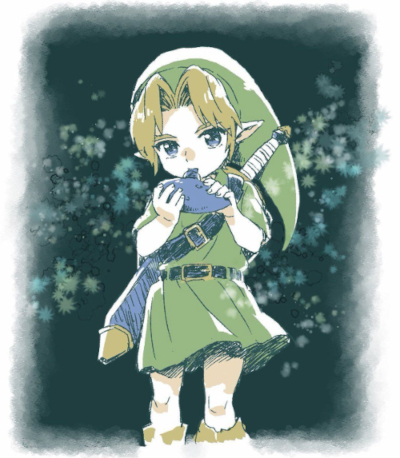
Ocarinas are among the easiest instruments to get started with. You can play tunes in only a few days, even if you have no prior experience with a musical instrument.
And listen to how they sound! Bright and happy, haunting and soulful, and everything between.
They're also portable, durable, and very inexpensive. You can buy a high-quality "oc" that will last a lifetime for only $30 or $40.
But which ocarina do you buy? Unfortunately, this choice isn't easy. The variety available can be overwhelming, and ocarinas are notoriously un-standardized. It's not unusual to waste money on a bad purchase.
In this post, we'll cover the kinds of ocarinas available and the differences between them. We'll give you buying tips that can help, whether you're buying your first ocarina, or looking to expand your collection.
Pick Your Shape and Material
Ocarinas come in three main shapes:
- Transverse, also called submarine or sweet potato
- Inline
- Pendant, also called seedpod
They're made of several different materials:
- Ceramic, also known as clay, baked clay, or porcelain
- Plastic
- Wood
This photo shows a few of the possibilities:
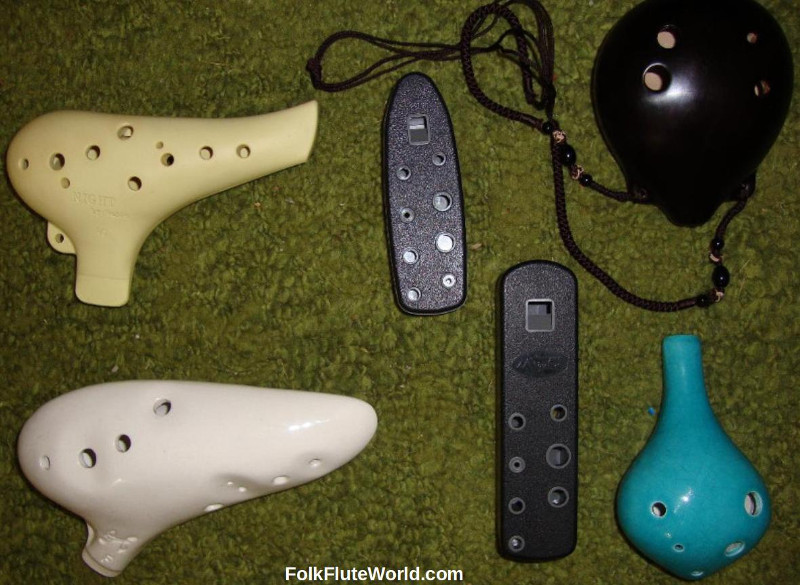
To the left are two transverse ocarinas (or "ocs"). The yellow one is plastic, while the white one below it is ceramic.
In the middle, shaped like TV remotes, are two plastic inlines. You play them extended straight out from your mouth, just like a recorder.
To the right are two pendants or seedpods. Both are ceramic. As you can see, their shapes vary. One fun feature of small pendants is that you can wear them around your neck. They typically come with a lanyard (necklace) for wear.
Fun Pendants
Some pendants come in cute shapes, and many folks enjoy collecting them. Check these out: everything from dolphins, dragon eggs, sea turtles, and a tea cup, all the way to acorns, mushrooms, and butterflies. They're all playable musical instruments.
And by the way, you can both drink from and play the teacup!
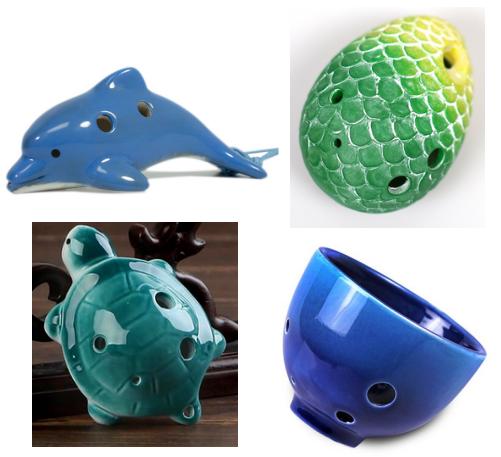
(Courtesy of Songbird Ocarina and other vendors)
Pendants are fun to play and many enjoy collecting them. There's much more to know than what we can ilnclude here. For more about the fascinating pendant
universe, see my article
Learn to Play Pendant Ocarinas.
All the ocs in the above photo play beautifully. But beware! Some eye-catching specimens do not. You can tell whether an oc is playable by inspecting its fingering holes. If all the holes are the same size, it's strictly for your display shelf. Playable ocarinas have differently-sized top holes.
Look closely, and you can see that these pendants are cute, but they're not playable musical instruments:
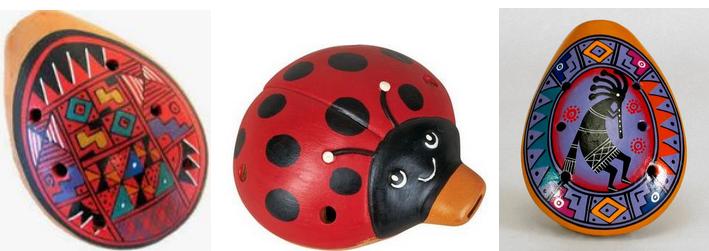
Photos courtesy of various vendors
If you buy online, you really need to know all the in's and out's of "fake flutes." For more about how to detect them, see my article How to Spot Fake Flutes.
Ocarina Basics
Here are some key facts about ocarinas:
Size: Smaller instruments are usually louder and cost less. Larger ocs are usually softer-spoken and cost more.
Ceramic versus Plastic: Ceramic is traditional, so purists favor it. Others feel that plastic sounds just as good, and note that if you drop a plastic oc it probably won't break, whereas dropping a ceramic one can be disastrous.
Transverses and Inlines versus Pendants: Transverse and inlines finger much like any simple flute: you ascend the scale by progressively removing your fingers from the holes. That's pretty simple.
Pendants finger differently. They don't follow such a simple pattern, so you must memorize the notes. That's not hard to do, but still, most consider transverses and inlines easier to learn than pendants.
6- and 4- hole Seedpods: Pendants or seedpods come in 6-hole and 4-hole varieties. 4-holers have just four holes on top, while 6-holers add two thumb holes on the underside of the instrument. 6-holers play a couple more notes than 4-holers. They are much more popular.
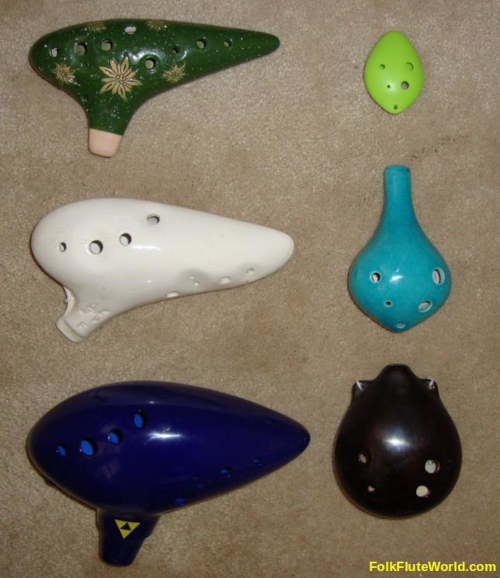
Key: You can buy an oc in almost any key. Here are the common sizes and pitches:
| Lowest Note: | Key: | |
| C Soprano | C6 | C Major |
| G Soprano | G5 | G Major |
| Alto | C5 | C Major |
| Tenor | G4 | G Major |
| Bass | C4 | C Major |
The left side of this photo shows three transverse ocarinas. From top to bottom they are an alto C, a tenor, and a bass.
The right side of the photo shows three seedpods. They are a C soprano, an alto C, and a tenor.
A Caution on Terminology
Ocarinas are famously un-standardized, and that extends to their terminology.For example, most people call the most common size of ocarina the Alto C. Its lowest note is the same C as the soprano recorder (C5).
But a few call this instrument a Tenor, most notably the major US vendor STL Ocarina.
To keep this straight, see if the oc is labeled a C major ocarina. If so, it's your popular Alto C, regardless of whether it's referred to as an Alto or a Tenor.
The best way to identify an ocarina's pitch and size is to verify these two attributes:
- The key of the instrument
- Its lowest note
Range
The big advantage to ocarinas is that they're so easy to learn to play. Plus, they're portable, durable, and inexpensive.
On the downside, they play a limited range of notes. The number of notes they can play is dictated by how many fingering holes they have:
| Number of Holes: | Whole Notes: |
| 12 hole transverse | 13 |
| 10 hole transverse or inline | 11 |
| 6 hole seedpod | 10 |
| 4 hole seedpod | 8 |
The range includes all sharps and flats. It's enough to play any tune you like, but sometimes you'll have to play a tune in a key your ocarina can handle.
Multi-chamber ocarinas overcome these range limitations. They have either two or three different enclosed chambers, each set to a different pitch range.
You pick the range you want by blowing into one of the different mouthpiece slits, and also moving your fingers to the appropriate set of finger holes. So they can play from two to three full octaves.
These photos show that you can recognize multi-chambered ocs by their multiple rows of fingering holes.
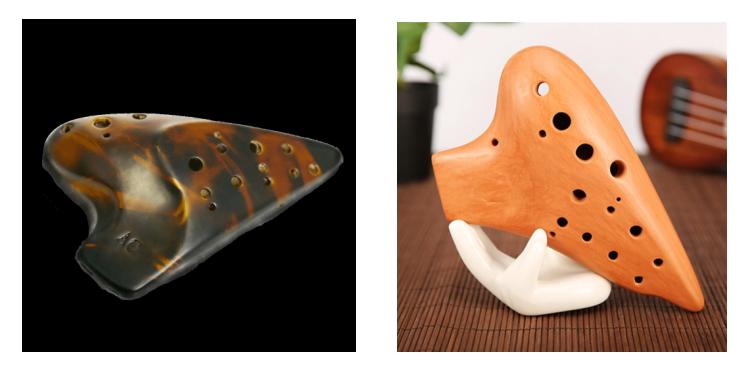
Photos courtesy of vendors
Multi-chambered ocarinas are both harder to play and more expensive, so stick with the common single-chamber oc for your initial purchase. I only mention these advanced ocs here so that you're aware of the possibilities.
Verify The Tuning
Ocarinas are folk instruments. When it comes to molding and baking a clay instrument, quality control varies from outstanding to abysmal.
Where this particularly matters is in the tuning. Unlike many musical instruments, ocarinas have no separate mouthpiece to move in or out to change the pitch. All you can do is blow either harder or softer. That's not a good way to correct an out-of-tune instrument, so you want to ensure any oc you buy is accurately tuned.
The problem is that a few ocs are not
in tune with standard concert pitch -- a C major oc might not
actually start its scale with an accurate C major.
Other ocs start on an accurate base pitch, but are not
in tune with themselves. In other words, some notes don't sound at the proper
relative pitches to the base note.
And many ocs are in tune except for one or two notes. The
out-of-tune notes are typically the highest or lowest ones, or
sometimes the sharps and flats.
How do you know the oc you want to buy is in tune?
One tip is to buy a name brand ocarina from a trusted seller for your first oc. Avoid the home-made oc on Etsy or the cute collectible unless you've verified they're accurately tuned.
My recommendations for your first oc are below.
Listen to Sound Samples & Read Reviews
The best way to ensure you're buying an ocarina you want is to hear how it sounds. Either play it yourself before purchasing, or listen online to sound samples.
When you listen online, follow these tips:- Listen with a keen ear to the highest and lowest notes. Do they sound clearly and are they in tune?
- Studio equipment -- microphones and post-play editing -- can make a big difference in what you hear. Is the audio unfiltered or has it been "cleaned up" by audio-editing software?
- You may not sound as good as the skilled player you listen to
You'll want to access whatever reviews you can. Youtube offers video reviews with tunes and sound samples. Just search for the ocarina by name that you want to learn about.
David Erick Ramos' Youtube channel has many objective product reviews, as well as free lessons and tutorials on how to play. You'll also find both sound samples and reviews at The Ocarina Network and Amazon. Check out my own reviews here.
To ask questions before you buy, post queries at The Ocarina Network's website, their Facebook group, and at Reddit's Ocarina Community.
Go With A Trusted Seller and Brand
I always like to know who makes any item I buy, don't you?
Hard to believe, but that's not always easy to figure out with an ocarina! Many of the biggest ocarina sellers -- trusted names like Songbird Ocarina, Thomann Music, STL Ocarina, and Stein Ocarinas -- often don't tell you who makes the ocs they sell. To add to the confusion, they may both import ocs and manufacture their own.
Since sellers don't always label makers, the only way to discover this is to do some googling. By cross-checking websites, you can usually determine an oc's manufacturer.
I've found consistent quality in name brands like Focalink and Night by Noble. OcarinaWind and TNG also produce excellent musical instruments, but avoid their lower-end, lower-priced ceramic offerings.
About lower-priced clay ocarinas... this is where that tuning issue I mentioned sometimes pops up. Inexpensive clay ocs often work fine, but you're taking a chance on quality control. Buy 10 top-rated ceramic ocs from Amazon in the $20 to $40 range, and you'll have a group of good ocarinas. But you might run into one or two that are off-key on a note or two, or have mediocre tonal quality on some notes.
If you're buying your first ocarina, you definitely do not want to face such issues. You'll never know whether it's you or the ocarina that is at fault for some shortcomings. This is why I'd recommend a brand-name plastic oc for your first purchase.
My Recommendations
So what's the bottom line? Is there a specific oc a beginner should buy?
Although any ocarina might work for you, nearly everyone starts with a transverse Alto C. It's a good first purchase because it fingers intuitively, plays the widest range of notes, and plays sheet music written for other C major instruments, such as the soprano recorder. Plus, you can easily find a quality instrument that plays in tune.
For a first Alto C in plastic, the choice is easy. Many in the ocarina community agree that two excellent ocs are the Focalink Bravura and the Night By Noble. Here they are:
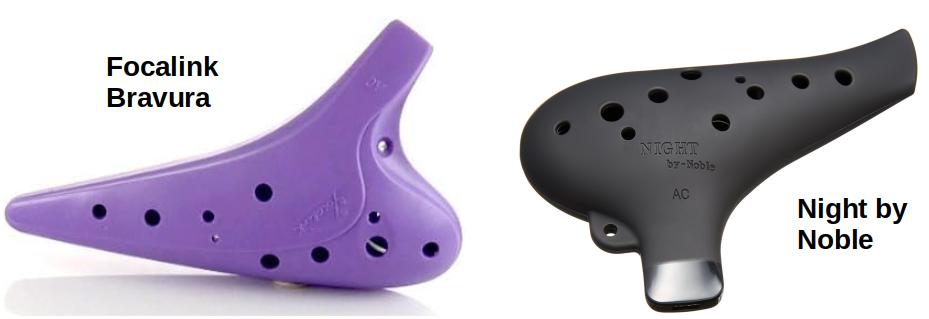
Photos from the vendors
These are usually priced in the $30 to $40 range. They can be purchased at Songbird Ocarina, Stein Ocarina, or Amazon. Plastic molding processes ensure you don't face any quality control risks.
Making a recommendation for a ceramic Alto C is more difficult. Many of the ceramic Alto C's in the $20 to $40 range at Amazon boast 4 1/2 reviewer stars. And many of these ocs are excellent.
But you always stand a small chance of getting a poor specimen due to uneven quality control. It's not at all unusual to get a good ocarina -- that voices one or two notes out of key. Or, that has excessively airy high notes. Or muffled low ones.
The way around this issue with ceramic is to jump to a higher price range. For example, in the $80 range I can recommend either Focalink's Pastoral or Rose series ocs. Both offer consistently high quality at a reasonable price:
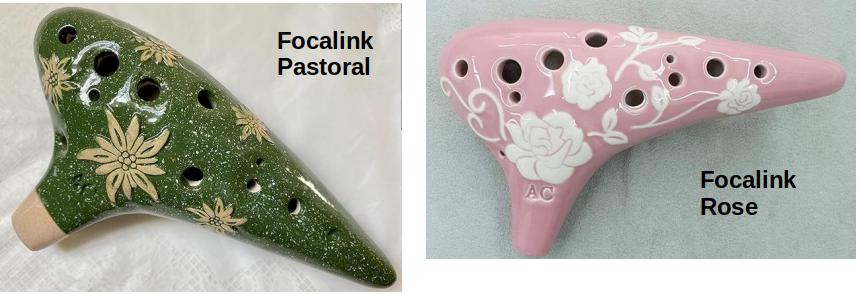
Photos courtesy of the vendors
If you're concerned about the cost of a quality ocarina, be sure to comparison shop. For example, Focalink ocs are made in Taiwan and sold through resellers in the US and EU. You'll find substantial price variations based on availability, shipping costs, and currency conversions.
Learning to Play
Once you've bought your oc, you've got everything you need! All the other resources you need are free:
Click here for our list of free self-taught online courses and other community resources.
Click here to find lots of free instructional material over at Youtube.
Click here to find a ton of freely downloadable sheet music.
Click here for many other free resources.
Summary
While ocarinas are among the easiest instruments to learn to play, it can be challenging to make risk-free purchases online. I hope these tips help.
Related Articles
You might like to read our related articles on ocarinas...
The Fun History of Ocarinas
C Soprano Ocarinas
Bass Ocarinas
The Highest Pitched Flutes